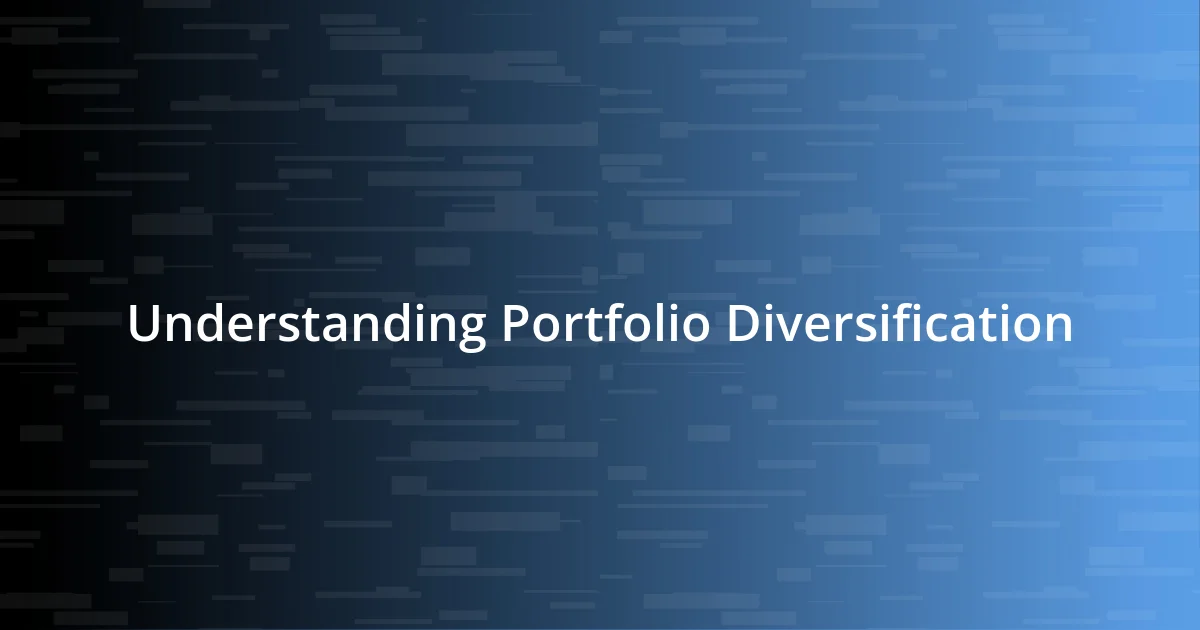Key takeaways:
- Diversification spreads risk across various asset classes, providing stability and reducing the impact of market volatility on a portfolio.
- Regularly reviewing and rebalancing investments is essential to align with changing market conditions and personal risk tolerance.
- Understanding personal risk tolerance and emotional responses to market fluctuations is crucial for making informed investment decisions.

Understanding Portfolio Diversification
Diversification is essentially about spreading your investments across various assets to manage risk effectively. I remember when I first started investing; I focused solely on one stock, convinced it was a surefire win. That excitement quickly turned to dread when the company’s share price plummeted. Isn’t it nerve-wracking to put all your eggs in one basket without a backup plan?
When I learned about diversification strategies, it was like a light bulb moment. I began to realize that by combining different asset classes, such as stocks, bonds, and real estate, I could cushion my portfolio against market volatility. It’s not just about having a variety of investments; it’s about understanding how they react to market changes. Have you ever considered how a market downturn affects your entire financial future? For me, this realization brought a sense of security and control.
It’s fascinating how some investors still cling to the idea of betting big on a single opportunity. I often find myself wondering why they overlook the peace of mind that diversification offers. By balancing risk and potential gains, I’ve discovered that I can sleep better at night, knowing my financial future isn’t riding solely on one investment’s success. What about you? Are you ready to embrace a broader investment approach?

Benefits of Portfolio Diversification
Diversifying my portfolio opened doors I never knew existed. I vividly recall that anxious moment during a market downturn when I had most of my investments tied to one tech stock. It was alarming to see the market volatility hit hard, but I felt a lot better knowing my other investments, like bonds and real estate, were holding steady. That experience taught me first-hand how diversification serves as a safety net against sudden market shocks.
Consider these key benefits of portfolio diversification:
- Risk Management: Spreads out risk across different asset classes, reducing the potential impact of a poor-performing investment.
- Consistent Returns: By mixing assets, I’ve found that my portfolio tends to show more consistent returns over time.
- Exposure to Opportunities: Diversifying allows me to tap into various sectors and geographical markets, enhancing the potential for growth in unexpected places.
- Psychological Comfort: Knowing that my investments are not solely dependent on one market or sector gives me peace of mind, making the idea of “holding” much less stressful.
It’s like having a safety net while walking a tightrope; I can balance my expectations without the fear of falling into financial disaster.

Key Strategies for Effective Diversification
Creating an effective diversification strategy is key to managing investment risk. One approach I’ve found especially beneficial is asset allocation. By consciously distributing my investments across various asset classes, I’ve been able to lessen the impact of a downturn in any single sector. For instance, during a recent market dip, my real estate holdings provided a buffer against the losses I incurred in tech stocks, reinforcing the idea that mixing asset types can lead to more resilience in my portfolio.
Another strategy I employ is to look beyond traditional investments. In my experience, including alternative investments, such as commodities or emerging markets, not only broadens the portfolio but unearths potential growth areas that mainstream stocks may miss. This reminds me of a time I decided to invest a small portion of my funds into renewable energy. That decision not only paid off but also aligned with my values, showcasing how diversification can reflect personal beliefs while enhancing returns.
Finally, regularly reviewing and rebalancing my portfolio is essential. I’ve learned that markets change and so should my investments. Every six months, I assess my allocation to ensure it aligns with my risk tolerance and financial goals. This practice not only allows me to adjust to market shifts but also to reallocate gains from strong-performing assets into underperforming ones, which is a strategy that feels more proactive and empowering. Have you considered how often you evaluate your portfolio for effective diversification?
| Strategy | Description |
|---|---|
| Asset Allocation | Distributing investments across different asset classes to reduce risk. |
| Alternative Investments | Including non-traditional assets to discover potential growth opportunities. |
| Regular Rebalancing | Frequent assessment of portfolio to align with market changes and financial goals. |

Assessing Your Risk Tolerance
Understanding your risk tolerance is crucial when it comes to investing. I remember when I first dipped my toes into the stock market; I was excited but also terrified. I had to ask myself, “How much am I willing to lose if things go south?” It was a tricky question. After some reflection, I recognized that my comfort level was low because I had family responsibilities and future plans that depended on my investments.
To assess my risk tolerance, I created a simple checklist that included my financial goals, investment timeline, and past experiences with market fluctuations. For example, when I lost some money during a market correction, I noted how it affected my peace of mind. Did I panic or remain calm? That moment taught me that my emotional response to loss heavily influenced my risk decisions. I realized I preferred a more conservative mix to avoid the stress that comes with high volatility.
Now, I often engage in self-reflection before making significant investment decisions. It’s like a mental check-up. I might ask myself, “Am I ready for potential losses in exchange for higher potential returns?” Sometimes, this inward questioning has led me to adjust my portfolio to improve my emotional comfort—I believe that aligning investments with one’s personal risk threshold is essential for long-term success. What about you—how do you gauge your own risk tolerance?

Diversifying Across Asset Classes
Diversifying across asset classes is one of the most powerful tools I’ve experienced for managing investment risk. For instance, when I first invested in bonds while heavily leaning into stocks, I was amazed at how the bonds provided a cushion during turbulent market phases. They acted as a stabilizing force, which made me realize that smiling at the ups and downs of the stock market can be a lot easier when you have a safety net.
I also learned that branching out into less conventional asset classes can open fascinating doors. A while back, I ventured into art investments, thinking it was a bit of a gamble. Surprisingly, not only did I enjoy the thrill of owning pieces I was passionate about, but some of those investments significantly appreciated over time. Have you ever thought about how your hobbies or interests could influence your investment choices? Finding alignment between passion and finance can yield a rewarding experience.
Moreover, I’ve discovered that the balance of different asset classes should reflect my personal circumstances and goals. With life events like marriage and starting a family, my strategy evolved. Each time, I revisited my portfolio, adjusting my allocations to ensure I was comfortable with the level of risk I was taking. It’s essential to remember that diversification isn’t just about spreading money around; it’s about creating a strategy that resonates with your current life stage. What adjustments have you made in your own journey to ensure your portfolio feels just right?

Managing Your Diversified Portfolio
Managing a diversified portfolio requires continuous attention and thoughtful adjustments. I vividly recall a moment when I realized I was too focused on one or two promising stocks, neglecting the overall health of my portfolio. After a disappointing quarter, I took a hard look at my allocation strategies and acknowledged I needed to rebalance. This experience taught me that regular reviews are a necessary practice to ensure no single investment carries too much weight.
When it comes to managing my portfolio, I often find myself asking, “Is this allocation still relevant to my life goals?” For example, after becoming a parent, I shifted my focus toward investments that offered more security and stable returns, rather than chasing high-risk opportunities. Balancing short-term whims with long-term vision has become a guiding principle for me, helping me prioritize what’s truly important in my financial journey.
Additionally, communicating with fellow investors has been invaluable in my management approach. By sharing insights and strategies, I have often discovered new perspectives that prompted me to rethink my decisions. I remember a friendly debate with a mentor about emerging markets; his enthusiasm was contagious and led me to explore areas I’d overlooked. This interaction not only enriched my understanding but also cemented the importance of community in managing a diversified portfolio. Have you had similar experiences that reshaped your investment strategies?

Evaluating Performance and Adjustments
Evaluating the performance of a diversified portfolio is more than just looking at numbers; it’s about understanding how those numbers reflect my overall investment strategy. I remember the time I realized that even though some assets were underperforming, others were thriving, and the overall balance was still achieving my goals. This experience motivated me to create a personalized performance assessment framework that not only highlights gains and losses but also tells the story behind them. Are you taking the time to reflect on the narrative your portfolio is weaving?
As I analyzed my portfolio’s performance, I found that setting specific benchmarks was crucial. There was a phase when I aimed to exceed an annual return of 8%, but halfway through, it became clear that some investments weren’t aligned with that goal. This realization prompted me to make necessary adjustments, reallocating funds towards sectors showing steady growth. I’ve learned that flexibility in adjusting targets can transform setbacks into growth opportunities. What benchmarks do you have in place, and how might they evolve with time?
Adjusting my portfolio isn’t just a mechanical process; it often feels like recalibrating a compass. After recognizing a downward trend in a few sectors, I felt a twinge of anxiety. It forced me to confront my emotions and reevaluate my risk tolerance. Embracing that discomfort encouraged me to diversify further, exploring options like green energy stocks. Engaging with those feelings ultimately made my portfolio more resilient. Do you find that your emotional reactions to the market influence your investment decisions?














